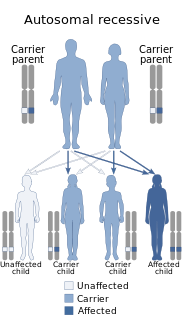
Spinal muscular atrophies (SMAs) are a genetically and clinically heterogeneous group of rare debilitating disorders characterised by the degeneration of lower motor neurons and subsequent atrophy (wasting) of various muscle groups in the body. While some SMAs lead to early infant death, other diseases of this group permit normal adult life with only mild weakness.

Spinal and bulbar muscular atrophy (SBMA), popularly known as Kennedy's disease, is a progressive debilitating neurodegenerative disorder resulting in muscle cramps and progressive weakness due to degeneration of motor neurons in the brainstem and spinal cord.

The anterior grey column is the front column of grey matter in the spinal cord. It is one of the three grey columns. The anterior grey column contains motor neurons that affect the skeletal muscles while the posterior grey column receives information regarding touch and sensation. The anterior grey column is the column where the cell bodies of alpha motor neurons are located.

Progressive muscular atrophy (PMA) is a very rare subtype of motor neuron disease (MND) that affects only the lower motor neurons. PMA is thought to account for around 4% of all MND cases. This is in contrast to amyotrophic lateral sclerosis (ALS), the most common form of MND, which affects both the upper and lower motor neurons, or primary lateral sclerosis, another rare MND variant, which affects only the upper motor neurons. The distinction is important because PMA is associated with a better prognosis than classic ALS.

Spinal muscular atrophy (SMA) is a rare neuromuscular disorder that results in the loss of motor neurons and progressive muscle wasting. It is usually diagnosed in infancy or early childhood and if left untreated it is the most common genetic cause of infant death. It may also appear later in life and then have a milder course of the disease. The common feature is progressive weakness of voluntary muscles, with arm, leg and respiratory muscles being affected first. Associated problems may include poor head control, difficulties swallowing, scoliosis, and joint contractures.

Survival of motor neuron or survival motor neuron (SMN) is a protein that in humans is encoded by the SMN1 and SMN2 genes.

Survival of motor neuron 1 (SMN1), also known as component of gems 1 or GEMIN1, is a gene that encodes the SMN protein in humans.

X-linked spinal muscular atrophy type 2, also known as arthrogryposis multiplex congenita X-linked type 1 (AMCX1), is a rare neurological disorder involving death of motor neurons in the anterior horn of spinal cord resulting in generalised muscle wasting (atrophy). The disease is caused by a mutation in UBA1 gene and is passed in an X-linked recessive manner by carrier mothers to affected sons.

Distal spinal muscular atrophy type 1 (DSMA1), also known as spinal muscular atrophy with respiratory distress type 1 (SMARD1), is a rare neuromuscular disorder involving death of motor neurons in the spinal cord which leads to a generalised progressive atrophy of body muscles.

Survival of motor neuron 2 (SMN2) is a gene that encodes the SMN protein in humans.
Distal hereditary motor neuronopathies, sometimes also called distal hereditary motor neuropathies, are a genetically and clinically heterogeneous group of motor neuron diseases that result from genetic mutations in various genes and are characterized by degeneration and loss of motor neuron cells in the anterior horn of the spinal cord and subsequent muscle atrophy.

Spinal muscular atrophy with lower extremity predominance 1 (SMALED1) is an extremely rare neuromuscular disorder of infants characterised by severe progressive muscle atrophy which is especially prominent in legs.

Spinal muscular atrophy with progressive myoclonic epilepsy (SMA-PME), sometimes called Jankovic–Rivera syndrome, is a very rare neurodegenerative disease whose symptoms include slowly progressive muscle wasting (atrophy), predominantly affecting proximal muscles, combined with denervation and myoclonic seizures. Only 12 known families are described in scientific literature to have SMA-PME.

Congenital distal spinal muscular atrophy is a hereditary condition characterized by muscle wasting (atrophy), particularly of distal muscles in legs and hands, and by early-onset contractures of the hip, knee, and ankle. Affected individuals often have shorter lower limbs relative to the trunk and upper limbs. The condition is a result of a loss of anterior horn cells localized to lumbar and cervical regions of the spinal cord early in infancy, which in turn is caused by a mutation of the TRPV4 gene. The disorder is inherited in an autosomal dominant manner. Arm muscle and function, as well as cardiac and respiratory functions are typically well preserved.

Nusinersen, marketed as Spinraza, is a medication used in treating spinal muscular atrophy (SMA), a rare neuromuscular disorder. In December 2016, it became the first approved drug used in treating this disorder.

Monomelic amyotrophy (MMA), is a rare motor neuron disease first described in 1959 in Japan. Its symptoms usually appear about two years after adolescent growth spurt and is significantly more common in males. MMA is reported most frequently in Asia but has a global distribution. It is typically marked by insidious onset of muscle atrophy of an upper limb, which plateaus after two to five years from which it neither improves nor worsens. There is no pain or sensory loss associated with MMA. MMA is not believed to be hereditary.

Spinal muscular atrophy with lower extremity predominance 2A (SMALED2A) is a rare neuromuscular disorder characterised by muscle weakness predominantly in legs. The disorder is usually diagnosed shortly after birth; affected children have a delayed motor development, waddling gait, difficulties walking, sometimes develop spasticity. Sensation, swallowing and cognitive development are not affected. The disorder is slowly progressive throughout the lifetime.

Spinal muscular atrophy with lower extremity predominance 2B (SMALED2B) is a rare neuromuscular disorder characterised by generalised muscle weakness. Decreased foetal movement is apparent already before birth. The child is born with a generalised muscle weakness (hypotonia) and contractures resembling arthrogryposis multiplex congenita, respiratory insufficiency and sometimes facial deformations. The disorder is frequently fatal in early childhood.










